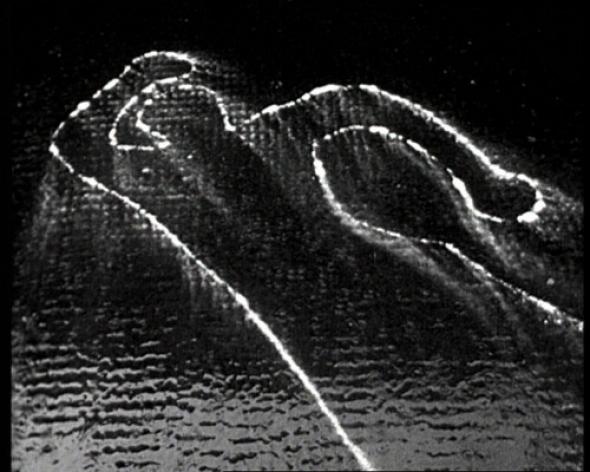Eliminating Labour: Aesthetic Economy in Harun Farocki
Reading across the expanse of Harun Farocki's oeuvre at his recent Raven Row retrospective, Benedict Seymour discovers a profound engagement with capitalism's ongoing crisis of devalorisation. How, he considers, does the eye/machine of Farocki's cinema operate on and within this process?
As if the world itself wanted to tell us something
- Harun Farocki, ‘Workers Leaving the Factory'
In reality, political films are very often screened in the exact same place as they always were: in former factories, which are today, more often than not, museums.
- Hito Steyerl, ‘Is a Museum a Factory?'
Today, one can only be practical by posing contemporary problems where they have, in fact, always been located: not in the ‘factory' [...], but at the level of the total worker (Gesamtarbeiter) and his alienated phantom, the total capital. Any other way of posing questions can only lead to the practice of what we have called the ‘left wing of devalorization'.
- Loren Goldner, ‘The Remaking of the American Working Class'
Against What? Against Whom?, the retrospective of Harun Farocki's video installations at Raven Row in London, was an overdue opportunity to explore the German film-maker and writer's work. Intelligently curated by the gallery's director Alex Sainsbury, the show comprised of Farocki's two-or-more-screen video pieces, from the first, Schnitstelle (Interface, 1995) to his latest Immersion (2009). It was accompanied by a season of Farocki's films at the Tate Modern and the publication of a new book of texts and essays on and by Farocki edited by Antje Ehman and Kodwo Eshun. In addition, Raven Row made available a good selection of his films which could be viewed on a monitor in the entrance of the gallery.
This constellation of exhibition, publication and screenings, not to mention audiences with the director and his collaborators during the course of the show, was quite a revelation. The range and continuity of Farocki's concerns across different media and over several decades became apparent in the matrix of inter-related ‘themes': the symbiotic relationship of (image) technologies across military, consumer and productive spheres, the centrality of technological and pedagogical simulation in an increasingly performance-based capitalism, a rigorous and self-scrutinising investigation of the language of cinema and television. But beyond this there was an unexpected, and timely, re-encounter with some fundamental questions concerning (image) technology that have, by and large, been overlooked or marginalised in film studies. Whether Farocki would endorse this approach to his oeuvre I'm not sure, but the essays by Alice Creischer and Andreas Sieckman, Tom Hollert and Diedrich Diedrichsen in the book, and the simultaneous availability of the gallery installations and films such as Zwischen Zwei Kriegen (Between Two Wars, 1978), Wie man sieht (As You See, 1986), and Bilder der Welt und Inschrift der Krieges (Images of the World and the Inscription of War, 1988), encourage a reading of Farocki as above all an analyst and practitioner of ‘devalorisation' - perhaps the most consistent or possibly even the sole example in cinema.
Broadly, devalorisation is the Marxian name for the loss of value from productive assets arising through the technological displacement of labour, the depreciation of existing capital by more efficient technologies, and the failure to realise products' value on the market. Devalorisation can also be used to denote the technological-social-economic process of production/destruction whereby capital deals with its contradictions at the expense of people and things. From restructuring to crisis to war, devalorisation is both the result of and response to the contradictions of advanced capitalism.
In their form and content - not to mention their cultural and institutional context - Farocki's films and writings inscribe and are caught up within such processes of devalorisation. They begin with the multiple stigmata of this process, principally, perhaps, film itself as an agent for the displacement of labour from the process of production. Faced with the tendency of technology to undermine the very basis of profit in the exploitation of human labour, capital seeks to recompose value and so avoid a self-deflating downward spiral. This happens first of all by the reconfiguration of production and the re/production of the worker, and then, when this strategy is played out, by laying waste to human and infrastructural capital. In normal parlance it is ‘Keynesianism', but since this lays the stress on the monetary inflation and consumer economy which is necessary to the first stage of the process and tends to overlook the destructive second phase (though Keynes and his German precursor Hjalmar Schact did not), ‘devalorisation' is a more useful and less euphemistic name. Naming and renaming, as the Farocki retrospective and its title - Against What? Against Whom? - made plain, is also an important part of devalorisation: how we divide up reality and allot agency to parts of a social process is part of the constitution and re/production of that process. Capital has often had to ‘change up' and repackage its product, and both innovation and adulteration, spin-offs and start-ups are part of the process.
The theme of devalorisation is explicit in Farocki's early films such as Nicht Loschbares Feuer (Inextinguishable Fire, 1969) and Between Two Wars, but persists and finds ever greater immediacy in his subsequent work. After an overt Brechtian staging of the problematic (coded vignettes, soldiers scratching the true terms of real subsumption into the soil with their bayonets), devalorisation is progressively sublimated into the very texture of video works composed, as they are, out of ‘readymade' military-industrial images of consumption/destruction. The author is himself steadily displaced from production. In his latest videos and installations, Farocki's sensitivity to and inscription of devalorisation is so refined and precise that it bleeds from the interstices of the shots; rather than directly announcing his subject as narrative or theme it is there in the very instrumental (Farocki dubs them ‘operational', as opposed to expressive) images of which his films are constituted.
In works such as Auge/Machine III (Eye/Machine III, 2003) a two-screen work in the Raven Row show, the progressive recomposition of value is there in the hinges of the images, in the cut from the aesthetically embellished, animated cartoon of a second world war flying bomb made for the instruction of German pilots to the zero degree aesthetics-by-accident of a Cyclopean cruise missile's ‘suicide camera'. Progressive abstraction and instrumentalisation of the image, from aerial photography to CCTV and modern missile targeting software, means that the ‘inscription of war' is already the inscription of devalorisation. The film-maker responds in a kind of Brechtian self-amputation, rather than re-enacting these processes as narrative or searching for an image to represent them, he lets the images interrogate themselves. No need for CCTV camera players, the draining of narrative or mise-en-scene is already the truest index of the deepening alienation of the world. Here human labour has been reduced to the occasional monitoring of machine images (the ‘Eye/Machine'), a step sideways from production (and indeed, destruction) which Marx foresaw in the Grundrisse but whose enormity and perversity long since outstripped 19th century anticipations, not to say 1960s dreams of a ‘leisure society'. The film-maker mimics this elimination of the human, of labour, becoming a kind of latter-day Flaubertian artist-deity (or artist-engineer), absent from his own works, from the field of battle, but for occasional high precision textual or verbal fusillades. Unlike Benjamin's programme of converting authors into producers, however, this is authorship in an age of advanced non-reproduction. Farocki's authorial ascesis corresponds to a development of forces of production which are increasingly non-reproductive - innovations which eliminate the worker from the processes of (advanced) production while undermining the overall process of reproduction of the collective worker. Farocki's formal economies coincide with innovations in imprisonment, security, finance and systems of control. The latter contribute to the policing of the (post)industrial reserve army or support the reproduction of a growing (but vast) minority of non-productive servants of capital. As such they are ‘non-productive forces', or overtly destructive as in the case of the missile tracking systems in Eye/Machine III. Farocki's films map the growing indistinction between technologies of reproduction and destruction, the concomitant suppression of productive forces apparent within even the most advanced technologies.
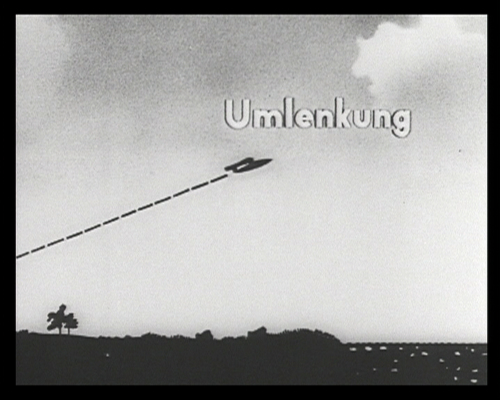
Image: still from Harun Farocki's Eye/Machine III, 2003
Farocki's large corpus of writings, particularly his essays in the now defunct Filmkritik, exist in a complementary relation to his films' apparently growing verbal reticence. Found images converse together, punctuated by measured, not to say minimal interventions that subtly underscore, nudge or counterpoint the patient, self-effacing work of montage. As Thomas Elsaesser observes in an interview with Farocki, the director is fascinated with (constant) capital's tendency to render the world superfluous - this becomes the logic of his own writing and film making, in which the author survives the demise of production as a shimmer of irony haunting every shot, reinflecting otherwise bald images of command/control with a kind of ‘grin without a cat' critique. Everything Farocki re-presents is turned ever so slightly on its axis by the process of montage, the occasional choice phrase, as in Benjamin's image of revolutionary transformation as a minimal change to the state of things that nevertheless makes all the difference. If nothing else, Farocki manages the sarcastic refunctioning of neoliberal teaching films, ‘capitalist Lehrstueck' as Kodwo Eshun and Antje Ehmann term them. A vast collective mis-education is turned against itself in films such as Leben - BRD (How To Live in the Federal Republic of Germany, 1990), the tragedy of corporate pedagogy turned into a grotesque but often highly amusing farce. Farocki's economy finds a solution to the old Adornian-Brechtian enigma of how to represent society without reducing its complexity and softening its horror by simply applying direct cinema techniques to capitalist Lehrstück. In the process both direct cinema and Brecht are dialectically transformed; filming and montaging the theatre which capitalism itself is perpetually staging and restaging in an era of accelerated restructuring and destruction turns it into satire, wordless auto-critique. Like the silent, unassigned images haunting the protagonists (and audience) of a Haneke film such as Caché, Farocki's absence leaves the images room to drown in their own uncanniness, or, as in a crystalline paean to the exquisite absurdity of commodity fetishism such as Still Life, to flicker in their bottomless ambivalence - at once utopian and ‘unimaginably' strange. Farocki reproduces a world in which imagination, and the image itself, are becoming increasingly straitened:
When you look at objects the people who produce them remain unimaginable. The spectator who understands this becomes unimaginable to himself. This is the departure for a new image of man.
The latter phrase itself reverberates in ironic ambivalence.
If devalorisation is Farocki's great theme, its primary cause, the elimination of living labour, seems to me to be the key leitmotif of his films. From the imposition of abstract labour in the phase of formal domination to the present ‘surreal subsumption' capital progressively evacuates and, tendentially, displaces work from re/production.i This theme is repeated across different cinematic registers and modes, from the symbolic and graphic figure of the worker's absent (dead) body outlined in chalk on the ground at the end of Between Two Wars (the post-WW1 revolutionary ‘gesammtarbeiter' first displaced from production then murdered by capital) to the lone worker silently superintending the automated pre-fabrication of a brick wall in contemporary Germany in Vergleich Über Ein Drittes (Comparison By A Third, 2007). Farocki presents this process of (technological) displacement dialectically, and globally, however - hence there is none of Negri or Baudrillard's one-sided totalisation or euphoria here, no simple ‘end' or ‘dematerialisation' of work. Instead what disappears at one pole of production is discovered re-emerging at another, running in strict (combined and uneven) parallel.
Comparison is a hypnotic two screen work contrasting the almost completely automated production of a brick wall in a cutting edge European factory with the very social and highly labour-intensive process of wall building in Africa. True to Farocki's notion of ‘soft montage' discussed in the essay of the same name reprinted in Against What?, one image is questioned and interpreted by another, held in a dialectical tension which forbids either nostalgia or unmediated technicist enthusiasm, neither the celebration of ‘appropriate technology' and ‘community' nor the worship of high tech and efficiency that is its complementary opposite in the global constellation of devalorisation. Farocki shows how the two poles posit and presuppose, but also interrogate and criticise, each other. The complete absence of commentary in this work is exemplary - the viewer is left to do the intellectual labour of reading and mediating the contrasting images. The most basic shot/countershot is sufficient to catalyse in the viewer an effort to narrate the stark contradiction, to somehow make sense of the coexistence of antithetical yet surely interconnected processes of (non) reproduction. The official story of capitalist progress and its contemporary extension (by evasion or inversion) into narratives of a seamlessly ‘flat' or irreversibly collapsing world, is baulked by the sheer complexity and hybridity of global production. Rather than progress or apocalypse, the possibility of a dialectical, revolutionary overcoming of the opposition sociality + poverty/ isolation + efficiency is present, but always in tension with the likelihood of intensified non-reproduction and the further deepening of the (brutal) contradiction Comparison begins with.

Image: still from Harun Farocki's Comparison by a Third, 2007
Since the '80s Farocki has increasingly worked under a self-imposed taboo against the staging of material, instead relying respectively on a very particular form of direct cinema and found footage:
No actors, no images made by myself, better to quote something already existing and create a new documentary quality. Avoid interviews with documentary subjects; leave all the awkwardness to the idiots you distance yourself from.
Eshewing unnecessary labour like a good capitalist engineer fine-tuning his critical-analytic machine, Farocki formally assimilates and assumes the same process of (self)abolition which is both capital's historic mission and - potentially - the grounds for a fully socialised, fully human technology. Farocki's unalienated labour, vanishingly thin as it becomes, is continually played off against the alienated labour his films scrutinise and seek to understand. One might question to what extent - here and in other aspects of leftist politics and culture - this ascesis is a dialectical challenge to capital or merely its double. Does minimalism shade into a moralised militantism, formal economy, as ‘negation of the negation' acting to produce a parallel politico-aesthetic devalorisation? Or, insofar as minimalism can helplessly undergo transubstantiation into the stuff of luxury (Raven Row is no third world building site), is an aesthetic of poverty - like other leftist cinematic propositions such as an ‘aesthetics of imperfection' - not doomed to become its niche marketed opposite?
But Farocki is ahead of such criticisms insofar as he explicitly thematises the contradictions of his work's own productive forces. His withdrawal from narrative cinema is at the same time, in parallel with capital's penetration of the personal, affective and communicational worlds of the (former) worker, the exploration of a vast new world of (un/productive) images. Farocki pioneers new fields and forms of image analysis by scouting the emergent scenes of capitalist devalorisation - supermax prisons, combat simulators, maternity class and police training exercise, or venture capitalist negotiation session. Capital's growing interest in training and rehearsing, simulating and re/modelling every inch of the ‘social factory' appears in Farocki's work as a project not of simple ‘expansion', but rather, I would argue, of involution and contracted social reproduction. Increasing precision is applied to increasingly unproductive and outright destructive functions. Work becomes an endlessly rehearsed performance in which nothing is re/produced but work; field of vision and field of fire merge with the gun/camera installations of the modern correctional facility. (I am thinking of Farocki's Ich glaubte Gefangene zu sehen [I Thought I was Seeing Convicts, 2000] which takes the Corcoran supermax prison in California as a site where guards effectively rehearse and stage gladiatorial combats between the inmates then shoot them down. The prison becomes a kind of (CC)TV studio churning out state snuff movies). Like a vast historical joke on the Maoist cultural revolution or Brechtian teaching programme, capital combines ceaseless re-education with the progressive scuttling of material existence.
Farocki's capitalism is not the accelerating, self-perfecting capitalism of Virillio or Deleuze, a system of diabolical, endlessly refined productivity but rather a process which for a long time has been developing through self-cannibalisation. The suspicion that Farocki surrenders masochistically to the conditions of this system by abjuring any direct expressive function of film is checked by his works own internal discipline. Instead, irony performs a dialectical escape act, rendering the muteness of developed capitalism voluble by letting its proliferating silences and scripted performances speak ‘for themselves' - ‘As if the world itself wanted to tell us something.' This adamic language is at its most amusing when the films are most ascetically reserved, witness again How To Live in the Federal Republic of Germany or Nicht Ohne Risiko (Nothing Ventured) - as sinisterly hilarious as reality TV would be if it could just shut up and pay attention to the pedagogical routines unfolding around us like a 24 hour biopolitical soap-opera. Arguably Farocki, professionally and critically involved with German TV throughout the '70s and '80s, invents reality TV in films like Leben - BRD, and to see these films today reminds us of how close this dystopian proletkult is to being a ruthless Marxian critique of everything existing.
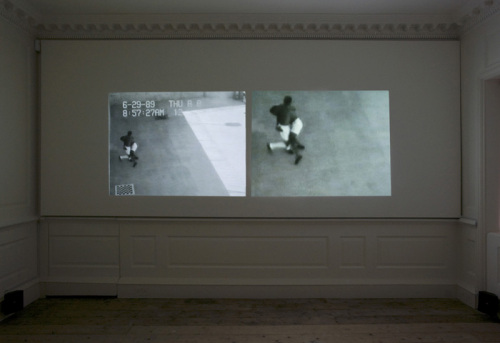
Image: installation shot of Harun Farocki's I Thought I was Seeing Convicts, 2000
So much for Farocki's formal strategy of austerity or ‘aesthetic of devalorisation'. Returning to devalorisation as ‘content', the Raven Row archive revealed a film-maker confronting capital's imperative head-on, beyond a certain point in its development, to wipe out not only over-valued exchange values (as in our current economic crisis) but, increasingly, the very forces of production - machines and humans, mental and environmental resources. Capital's drive to convert and multiply a single rationalised productive process to yield different or opposing outputs, to turn its forces of production against what it produces, remains ever present in Farocki's work. Farocki insists on the highly political nature of ostensibly neutral objects of consumption, underscoring the inseparability of productive and unproductive activity.
Already in Inextinguishable Fire, Farocki had examined the emblematic scandal of Dow Chemical, a company whose own technical efficiencies oblige it to turn its surplus (domestic, productive) output into materials for destruction and war - i.e. unsellable petroleum becomes napalm, shipped out to Vietnam where it is used to flay the bodies and environment of the ‘communist' antagonist. Rather than propaedeutically expose his audience to images of napalm's horrific effects, Farocki uses a kind of institutional tracking shot to makes visible in one movement the inseparability of the productive and destructive arms of a single company. Famously, Farocki, in the guise of a TV announcer, begins this movement by stubbing a cigarette out on his own forearm while the voice over explains that napalm burns at 3,000 degrees, a cigarette at just 400. This gesture has captured most of the discussion, but it is the succeeding sequence based around a Brechtian mock-up of Dow Chemical's internal division of labour that makes good the initial gestus (an ‘expanded reproduction' of the gesture?). The film is a study in the right hand's carefully constructed ignorance of what the left hand is doing, of a (self-)alienation which is not simply epistemological or ethical but institutional and systemic; hence Farocki's self-wounding gesture is not an actionist coup de theatre but rather a characteristically economical and accurate physical synopsis of the self-destructive (and necessary) separation that the system is predicated on. The ensuing analysis reveals that Dow is no isolated malefactor but rather simply one exemplary node in a vaster system of production/destruction. It is identified as a potential site of struggle and refusal, were the scientists employed there to start thinking their activity in its totality and practically refusing it in concert with other workers at different points in the division of labour. As such Dow is also, like the gesture of stubbing out the cigarette, only a metonym for other sites of struggle, other refusals to reproduce the structures and logic of devalorisation. Overt exhortations of this kind are notably absent from the director's later work, but the focus on the ambivalence of capitalist ‘rationalisation' remains a constant.
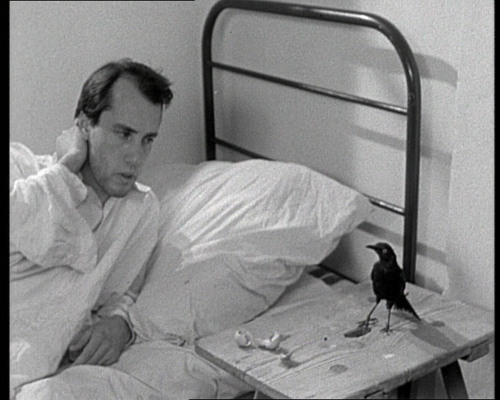
Image: still from Harun Farocki's Between Two Wars, 1978
In Farocki's films capital is a system of production, but above all of production through and at the cost of intensifying destruction. In Between Two Wars and the later film essays Wie man sieht (As You See, 1986) and Bilder der Welt und Inschrift der Krieges (Images of the World and the Inscription of War, 1988) Farocki develops the logic of Inextinguishable Fire's analysis to present a kind of Marxist version of Thomas Pynchon's Gravity's Rainbow. The recycling of waste products of capitalist and pre-capitalist culture is presented as the material for an increasingly schizophrenic and ambiguous economic expansion. On the one hand, the production line brings new economies of scale, on the other, the machine gun automates murder on a mass basis.
In Between Two Wars Farocki draws on the theorist Alfred Sohn-Rethel's Marxist analysis of the economy and class structure of fascism to posit an analogue between post-WW1 Germany and consumer capitalism after '68. In both eras the logic of devalorisation as rationalised irrationality - for example, the mass production of machine guns (and, one might add, financial instruments), as ‘solution' to an over accumulation of labour-power - is central, the answer capital gives to its ongoing crisis so as to contain and overcome the threat of a communist response. Farocki's films, in this period, seem to begin by constructing dialectical images, almost hieroglyphs for materialist interpretation. The key image of capital's self-destructive ‘recycling' in Between Two Wars is presented in a scene in which one worker tells another his dream, of a bird that hatches then eats its own egg. The second worker replies with the story of the scientist Kekulé - a story which Pynchon's novel also seizes on as symbolically pivotal. While he was working on the problem of the molecular structure of benzene (essential to Dow's later production of petrol and napalm), Kekulé dreamt of a serpent eating its own tail. His interpretation of this archetypal image of regeneration and the entwinement of life and death was radically disenchanted - the dream vision became a model for material production, stripped of symbolic meaning and turned into a topology.
Yet in Farocki's film Kekulé is not so much the spiritually impoverished seculariser of a spiritual metaphor as in Pynchon's melancholic (Weberian?) version, but rather a model of capitalist rational-irrationality. Converted into the structure for benzene, a figure of regeneration becomes real and practical. The second worker, like Kekulé, sees in the image of the bird eating its own egg a formula for immanently overcoming capital's problems, reorganising production such that the waste products of one process can help power another (‘a network of pipelines' would use exhaust gases from coking to heat blast furnaces for smelting.). The bird eating its own egg becomes the topology for the material recycling necessary to the rationalisation of production. In good Brechtian fashion the workers discuss the interpretation of dreams, the dreamer concluding (like a naive German left-communist of the era?) that science must submit itself to the imagination of labour, but that, generally speaking, the workers' dreams are instrumentalised and put to work by capital. As the film goes on to show, this first phase of devalorisation stores up a second. The image of a bird that devours its own product proves, with tragic irony, to be the emblem of the austerity of the '30s and of the succeeding imperialist war. Indeed, capitalist ‘efficiency' is shown as constitutively dependent on and productive of this austerity. The second worker's vision of the integration of different industrial processes through ‘total flow production' enables great leaps forward in output, but, once applied in practice, as in the German steel industry of the '20s, this very ‘rationalisation' results in an increasing contradiction between production and consumption.
In their essay in Harun Farocki: Against What Against Whom?, Alice Creischer and Andreas Sieckmann quote a section of the film which brings this all together:
In a scene set in 1932, the woman meets the blast-furnace man on a bridge. ‘I managed to have a look at the stenograph of a speech Hitler gave in an industrial club in Dusseldorf. If the world's entire car industry worked at 100% capacity, the entire car stock could be replaced within four and a half years. And this holds true for almost every industry. Increased production possibilities have become so high that today's market stands in no relation to them any more. [...] This Hitler guy talks like a Marxist'.
The ‘solution' to devalorisation becomes in turn its cause. And the socialists helped come up with it, playing the part of left wing of capital or better ‘the left wing of devalorisation', as Loren Goldner puts it. Excess of supply over demand and the inability to realise the value incorporated in products on the market led the capitalist class to find a new ‘solution' in the non-reproduction of workers. Having broken the resistance of the working class with the help of the unions and socialist parties, militarisation of the economy and, ultimately, war proved necessary to bring the market and the productive forces back into alignment. In Farocki's film, Nazism is revealed as the only political form capable of securing continued capitalist accumulation, projecting an image of national rebirth to mobilise and legitimate a process of social self-cannibalisation. Having perfected the Taylorist integration of production and the reproduction of workers, capital ends up, once again, micromanaging their murder. Recycling as rationalisation of production impels, as its necessary continuation, the outright destruction of value.
This contradiction between forces and relations of production and the resulting systemic tendency to self-consumption recurs across Farocki's subsequent works. Within capitalist social relations the virtuous circle of the scientist is inseparable from the vicious circle of the fascist. The bird eats its own offspring; a generation is sacrificed to ensure the reproduction of capital, not once but (at least) twice. And as Farocki's film implies, this contraction of social reproduction, this murder of the rising generations, is not a relic of the mid-20th century but very much the reality of the last 40 years' ‘neoliberal' global experiment. Moreover, Farocki's films seem from early on to refuse the comforting notion of a return to a social democratic ‘alternative' - instead they mercilessly expose the proximity of the workers' movement and fascism, of the productivist and nationalist left and right wings of socialism. Like Dow Chemical, socialism's productive and destructive arms can now be seen as inseparable, mutually constituting. The recognition may hurt, like a self-administered cigarette burn, but if one wants to stop reproducing the tragedy of capitalist ‘development' one must try and grasp it.
Deinstitutionalisation and/or Devalorisation Redux
Farocki's Between Two Wars, but perhaps even more so his film essays As You See and Images of the World, suggest the way in which the absence/elimination of the worker - in particular of the worker as conscious revolutionary subject - coincided with the consolidation of the worker as an identity. The same dialectic of devalorisation as a simultaneous affirmation and suppression of labour can be seen in the evolution of the form and content of cinema itself. The Raven Row show's installations, particularly Zur Bauweise des Films bei Griffith (On Construction of Griffith's Films, 2006) with its analysis of the invention of shot/countershot as a recalibration of the cinematic law of value, and Arbeiter verlassen die fabrik (Workers Leaving the Factory in Eleven Decades, 2006) enabled one to trace this evolution forward from the birth of cinema and the rise of socialism to the present crisis - of politics, economics and the moving image.ii
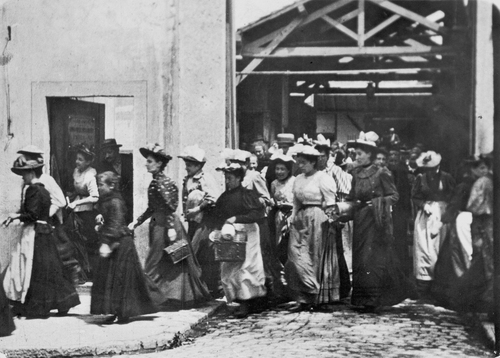
Image: still from the Lumières' Sortie des Usines Lumière à Lyon, 1895, used in Farocki's Workers Leaving the Factory, 2006
On Construction reveals the logic of Taylorism operating in cinematic form. The introduction of the shot/reverse shot gives us two sets for the price of one and enormously increases the transferential ‘productivity' of film grammar in the process. The individual performer's affective ‘output', and the integration of the viewer/consumer, is redoubled, while, arguably, the material conditions for the mass production of ‘stars' out of mere ‘actors' is put in place. The (abstract and abstracted) labour of the actor, like that of the factory worker, is further broken down into parts. It becomes at once more fascinating (for the viewer) and more boring (for the actor) - standing around waiting to manufacture torn halves of a virtual encounter; as Deleuze suggests, cinema acting becomes increasingly a matter of reacting.
The dialectics of (abstract, industrial) labour in cinema are pursued again in Workers Leaving the Factory. A row of 12 monitors showing excerpts from 11 decades of feature, documentary and promotional films, Workers does what it says on the can and shows workers leaving factories. It is not only a document of the evolution of film and of factories but, as Bert Rebhandl puts it in Against What?, it posits the continual ‘reappearance' of the Lumières' first film - the primal scene of workers exiting the inventors' photographic factory in Lyon (Sortie des Usines Lumière à Lyon, 1895). Farocki selects images of the literal departure of workers (or actors playing workers) from factories in films such as Intolerance, Metropolis, Modern Times, Il Deserto Rosso, and Dancer in the Dark as well as documentaries and documentary footage including a short scene outside a factory in Moscow from 1912, and La reprise du travail aux usines Wonder from May '68 (a Parisian worker who is leaving work when her bosses and union officials would like her to return: ‘No, I will not go back. No, I will not go back in there. I wouldn't put a foot in that prison. You could see what a shithole it is.'). Workers, by condensing film and labour history into a few screens and scenes, foregrounds the general absence of the factory as a subject in cinema. Without commentary, the installation implies that the cinematic apparatus is founded on a constitutive disavowal of production, both the world of industrial work from which the cinema classically posed an escape, and its own fantasmatic production line - the Taylorist, 24 frames-per-second machine behind and within the projected image.
As well as staging a cinematic ‘return of the repressed'- of work, and indeed of class struggle - Workers is simultaneously an analytic cross section in 12 slices of the long arc of the workers' movement: from revolutionary challenge to capital to vanguard of real subsumption to anti-bureaucratic revolt and on into a post-Fordist afterlife in which the installation itself (‘the line' become a line of monitors) represents the worker as revenant - since art spaces such as Raven Row are themselves sites of former industrial or artisanal labour. Hito Steyerl has wittily formulated the dialectic of the factory and museum that arises at the end of this arc in her essay ‘Is the Museum a Factory'. Rather than protesting the inappropriateness of showing radical film in the museum, she argues, we could say that the museum has simply returned to its original function: Factory - Museum - Factory, to refunction Marx's formula for the circulation of capital (Money - Commodity - Money). What this analysis misses, however, is the way in which the F-M-F spiral is not at all the upward movement of valorisation, M-C-M' (Money - Commodity - Money ‘plus an increment of surplus-value'), in which capital grows by being admixed with living labour. It's more of a downward spiral. The conversion of (no longer) productive factories into unproductive sites of consumption has served to expand fictitious capital, property values and the rest of the F.I.R.E. (Finance, Insurance, Real Estate) economy, but contributed precious little to the extraction of surplus value. The neoliberalised museum is more like a supermarket, the radical art space an organic farmer's market, in which a narrow section of the global unproductive classes g(r)aze more or less intensively while, through their presence, performing a rite of (fictitious) revalorisation upon the tranche of deindustrialised sub/urban space in which the museum or gallery is situated.iii
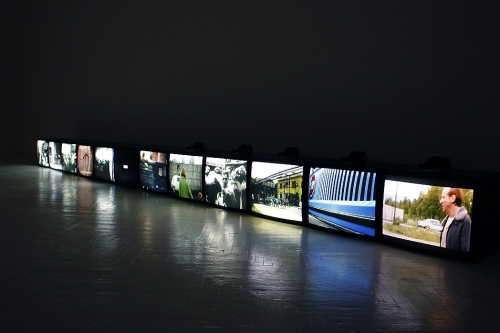
Image: installation shot of Harun Farocki's Workers Leaving the Factory in Eleven Decades, 2006
That this is part of the movement of devalorisation in its current form of advanced non-reproduction is shown in the signal failure of such performances to produce anything other than claims on value that is extracted elsewhere in the circuit of capital. The institutions of the cultural economy are now facing collapse and may well seek bail outs by private (even oligarchic?) capital. The museum as factory will have functioned at best as an advertisement for a new phase of accelerated looting - as in the case of Riga's new art museum. In this respect Farocki's Raven Row show was especially timely, and the question Against What? Against Whom? pointedly apposite given that Farocki's new visibility in the London art world was itself facilitated by Raven Row's director, heir to one of the great agents of the 20th century devalorisation of British labour-power, J. Sainsbury. As such the show marked the convergence, if not reconciliation, of the two wings of capitalist devalorisation. Socialist guerilla film-maker meets repentant scion of (super)market capitalism in neoliberal infinity. In an era of open capitalist crisis, the field of vision (or ‘distribution of the sensible' as Rancière would say) would seem once again to be undergoing a reconfiguration, the ‘operationality' of images - including expressive or critical images - is being recalibrated. Crisis not only resets the measure of value by driving down the price of labour-power, but sees a re-evaluation of underappreciated art. That which was shunned as ‘didactic' returns as a purgative for a bloated art market, while ‘hairshirt radicalism', as J.J. Charlesworth calls it, can easily end up reproducing an ideology of morally virtuous belt-tightening, making do and getting by. Among the middle class (and many artists) there is plenty of this sacrificial socialism which says we all have to take a bit of the pain if ‘things are going to get better'. As in the '20s and '30s, capitalism can today use remnants of leftist culture and its archive to provide cheap content (viz the ICA's ill-fated ‘radical experiment in deinstitutionalisation') and an ideological justification for austerity.
Consequently at the top end of the capitalist circulation of goods, austerity coincides with a promotion of ethical, intellectual, politicised and above all cheap art work. Of course this coexists with a ‘reactionary' lunge back to proven national brands - the ICA plans to reboot with a show of Jake and Dinos Chapman's work - but the utility of a left-wing ethos of DIY autonomy, restraint and economy in a period of deflation is not lost on capitalist institutions in crisis - both in the culture sector and in the EasyCouncil-style (private/)public sector beyond. The apparently incongruous convergence of private capital and political art and film is a straw in the wind indicating the imminent collapse of the neoliberal cultural surrogate for a ‘public sphere' that succeeded the state-funded regime (Arts Council and the dole). The eclipse of state funding will see the emergence of other sources of individualised private-public patronage, but their tastes may well be less ‘radical' than Sainsbury's. If the general tendency of recent decades is anything to go by, the new patrons could end up more on the model of Anita Zabludowicz (director/proprietor of 176 art space in North London) than Alex Sainsbury - the wives of arms' manufacturers and oligarchs, their tastes and commitment as fickle and superficial as Sainsbury's is informed and (comparatively) sustained. Even the most intelligent and engaged patron represents part of this wider process of cultural non-reproduction; new patrons, whether their money is new or old, are by their nature more autocratic and unaccountable than public bodies. Not to fetishise the latter, but their contraction or collapse is one more symptom of the ongoing destruction of value by and for capital; a ‘liberation' from bureaucracy, maybe, but from funding, definitely.
In this sense, I think we can take a page out of Farocki's analysis of Dow Chemical and see, behind the benign and human face of the ‘good' reproductive capitalism of Sainsburys and socialism, the true and destructive, devalorisationist economy of Zabludowicz. Behind the petrol, the napalm; beneath the farmer's market, the occupied settlements of East Jerusalem. And, lest this be misunderstood, this is not a matter of scapegoating any particular branch of capital or its bearers, the truth of the Sainsbury-Zabludowicz continuum (the shot and counter-shot of a process of contracting social reproduction, as it were) is not discovered by collapsing one into the other, but rather by seeing both as necessary to the continuation of accumulation - cultural and general.
Whereas scapegoating works by announcing the disciplining or even elimination of one part of capital, along with a portion of the working class, we should invert this dodgy equation and extend our critique from a fraction of the system to its totality. At the (rather over stage-managed) panel discussion for the launch of Against What/Against Whom? Kodwo Eshun seemed to cheerfully invert or abbreviate the lesson of Inextinguishable Fire. Celebrating the ‘liberating' post-crunch opportunity for naming and blaming culprits (evil bankers) in isolation worked to reverse or at least impede the movement of Farocki's montage. Stubbing a fag out on the ‘bad' financial arm of capital, or indeed the military arm of the culture-finance-military-(post-)industrial complex, may be a pleasure but is it any use when it leaves the relations of part to whole unexamined? The media heaves with naming and blaming ressentiment patently aimed at misdirecting any burgeoning opposition to the system as a totality. In the end the new liberal/artworld tolerance for a sub-Brechtian ‘crude thinking' of the kind that remains too ubiqitous in political art, reveals the superficiality of the politics as well as the aesthetics. Analysis lacks engagement with class as a decisive and relational rather than subsidiary and sociological concept - form, as in the value form AND aesthetic form (and the latter as a mode of exploring and opposing the former) is dominated by a rigid and politically correct combination of formalism and content-ism. Even most of the articles in Against What?, for example, which includes detailed discussions of Farocki's early attempts at Marxist pedagogy, seem to do without a historical-relational conception of class, if indeed class is mentioned at all. Foucault generally takes presidence over Marx, yet Farocki's films seem as much concerned with value as with control and ‘biopolitics'. In fact by exploring the link between these things/processes in a way which at least implies labour-power as a central category, Farocki's films and writings manage to be much more penetrating than many of the readings produced by their academic fans.
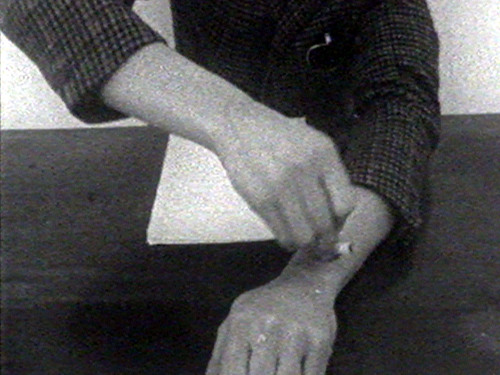
Image: still from Harun Farocki's Inextinguishable Fire, 1969
Unsurprisingly, in the absence of an analysis of class as relation, of labour as embodiment (and antagonist) of value, there is little discussion in this milieu of the myopias of leftist film. Not to mention the assumption - apparently alive and well - that the political insights of a fraction of the bourgeoisie have a privileged analytic or indeed practical value. Looking back from our present crisis to the social revolution of the '60s, in fact, one could argue that Farocki and his peers were actually in the rearguard of a proletarian refusal which did the real thinking, the active theorisation and education work, through the practice of the wildcat strike and the urban riot. We can propose a countershot that upsets the received idea that the ‘return' of the left to the cultural centre marks the renaissance of a repressed radicalism. What if the left who now return to denounce neoliberalism in crisis were, in their own youth, simply the vanguard of the retrogression that followed in subsequent decades?
The notion is not completely alien to Farocki. Having explored the complicity of the socialist movement in devalorisation in Between Two Wars, later films such as Etwas wird sichtbar (Before Your Eyes, Vietnam, 1982) engaged critically - but ambivalently - with the continuation of this legacy in the anti-imperialist movement of the '60s: ‘I had sided with the Vietcong without dealing with the politics of the victorious communist regime and without mentioning the boat people or the detention camps,' he confides in Against What? In ‘Dog From the Freeway', a text which accompanies Before Your Eyes, Vietnam, Farocki criticises the ‘identical mental mechanisms' of denial of the China-Cambodia and Soviet Union-Vietnam factions. Nonetheless he also retained loyalty to the ‘historical character' of the nationalist opposition to US imperialism and seems enthusiastic for the figure of the partisan and the guerilla activity of the Vietcong which here eclipses any notion of the revolutionary working class as primarily non- and anti-state (‘The working class and the employing class have nothing in common' as the IWW put it). The partisan is not the conventional soldier, yet as Carl Schmitt grasped, is a kind of microcosm of the state, an avatar who is given historical and intellectual consecration with the rise of the modern bureaucracy - not so much its other as its Clausewitzian continuation by other means. As such, those attuned to the predominance of a Hegelian ‘negation of the negation' statist perspective in 20th century socialism will recognise the dead hand of devalorisation behind the romantic figure of the freedom fighter.
In Farocki's essay, however, the ‘participative' and active citizenship promoted by the Vietcong is not subject to critique as the very form of a (bloody) capitalist agrarian revolution. For all Farocki's attentiveness to the manipulation of atrocity images by both ‘communist' sides and the ugly contradictions confronting the nationalist anti-imperialist position, he never seems to draw the logical conclusion - that the enemy of workers and peasants was not only American imperialism but their domestic bourgeoisie. This is a far cry from the prescient analysis of the Situationist International back in 1967: ‘The point [...] is not to give unconditional (or even conditional) support to the Vietcong, but to struggle consistently and without any concessions against American imperialism...' Although presumably Farocki would agree that ‘The Vietnam war is rooted in America and it is from there that it must be rooted out.'
With this tragic socialist betrayal of the working class in mind, one must wonder exactly how far one can rely on the teachings of Farocki. To what degree does the theoretical and practical elision of the working class as self-subsisting positive, as a form of activity radically opposed to the dialectical labour of negation of the Prussian state bureaucrat and his 20th century descendents, render Farocki's criticism of the image, of work, and of capitalist ideology itself complicit in the ongoing capitalist project of devalorisation? This particular absence/elimination of the working class - the one staged and re-staged by their social democratic, anarchist, and Trotskyist representatives - is the most serious one ‘in' (but never confronted by) Farocki's films.
Returning to the current struggle in the cultural sector, we can re-examine the question of what is at stake here. Despite Hito Steyerl's caveats, the (ongoing) return of radical cinema - first time in factories, second time in factories-turned-galleries - still seems farcically emptied of (the) class as such. One might hope that the current ejection of the gallery from the converted factory will produce a new class consciousness among those affected, but so far even this dialectical twist in the conversion spiral doesn't seem to have had much power to consolidate resistance. While the non-reproduction of the non-reproductive sector could be seen as one of the first tasks of revolution - capital doing our work for us - in this historical juncture I suspect it's a sign of weakness not strength: the lack of opposition at the deluxe end of the market reflects a wider passivity and insecurity. The division of labour which Farocki has sedulously explored in his films has evolved to the point where opposition may be less a matter of coordination across sectors - as espoused in Inextinguishable Fire - and more of an all or nothing rout or exodus. Having said that, a revolution without a programme for social reproduction as well as the abolition of work could be an even more effective agent of social contraction. Again, films such as Between Two Wars are a salutary reminder of capital's ability to raid the ‘dreams of the worker' and put them to work against them.
The Self-Excluding Worker
As I was watching Between Two Wars on the monitor in the entrance of Raven Row an actually existing proletarian, drunk, shouting, clutching a lager, burst in through the elegant Georgian doors of the white cube. He didn't hang around long enough to be ejected, but leapt back out almost instantaneously. It was tempting to consider this undisciplined, post-Fordist (non)worker as the missing final screen in Workers Leaving the Factory. There was something hallucinatorily absurd and scandalous about his brief visit, like an eidetic image of the supposedly ‘real world' which being in a gallery always conjures up (La vraie vie est ailleurs) but which almost never breaks in on the interior spectacle. The intruder/extruder was like the (bad) supplement to Farocki's haul of departing workers, the human surplus displaced by the super-efficient automated factory gates shown on the 11th monitor, perhaps. This real-life performance of the contemporary ‘eliminated worker' was, by contrast with How To Live's pageant of capitalist re-training exercises, completely unscripted, a ‘free improvisation' albeit a solo one. This was the pedagogy of (as in by) the proletariat - not scored by capital for labour's edification, but rather precision targeted, by accident, at the critic of self-critical leftist cinema - me. (Or was this just the typically narcissistic delusion of the film-viewer?)
In this case the worker was self-ejecting, appearing and disappearing without a trace. But his ad hoc intervention was enough to make the historical dialectic of labour's dis/appearance clearer. What Hollywood screened out - the factory - and socialism deified - the worker - it simultaneously destroyed; devalorisation made visible what it sought to eradicate, simultaneously consigning much of the labour force to the status of invisible non-People. The elimination of the worker coincides in the phase of Fordist devalorisation with a cult of the worker as identity and a cull of those identified as non-workers (Farocki's Images of the World is devastating on the Nazi deployment of this distinction in the camps, the exemplary space of capital's decision over life/death in terms of work/non-work). If the process begins with the birth of cinema - with the image of workers leaving the factory - in the present moment of crisis this displacement has come full circle; the museum as (social) factory is closing down all over the shop, everywhere we look the exit from the factory is being forcibly levered open and the worker expelled - by capital. The charade of cultural value production is discovered as a sham extension of a wider fictitious capital bubble. Rather than running for the exit, workers may think of occupation, or indeed of new forms of solidarity capable of turning this new ejection to their own advantage, a step - or leap - toward their self-abolition as capital. Meanwhile, the worker is said to remain absent from the stage of history, this time not concealed behind the reformist/devalorisationist carapace of a heroic identity but diffused, disaggregated, alienated from any class consciousness. It's ambiguous - is this the condition for the complete self-abolition of the working class or the current limit of anti-capitalist struggle? Either way, the worker who accidentally and drunkenly enters the art/politics factory is immediately repelled by sober acts of attention to black and white screens - perhaps he even glimpses Workers Leaving the Factory at the back of the space - and recoils?
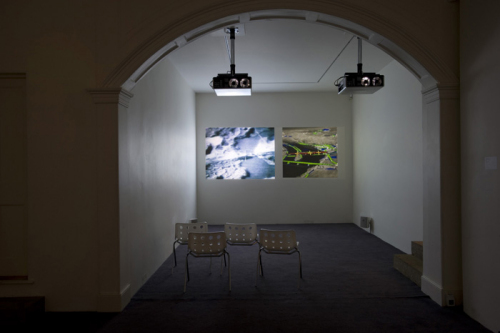
Image: installation shot of Harun Farocki's Eye/Machine III, 2003
Whether or not any of the current politicised discussion in cultural institutions amid cuts and lay offs, both front of house and behind the scenes, has any bearing on a resurgence of working class self-activity remains to be seen. What seems more certain is that while any real social movement opposing capital is absent in the UK, cultural workers discussing political action helplessly reproduce the position of an earlier generation of vanguardists. This is politicisation in an (aesthetic) vacuum, an empty space apparently increasingly dependent for its existence (inflation?) on the largesse of private capital. The absence of the working class is thus as ambivalent as ever - my guess is that Farocki's current art-world sponsors represent the displaced last gasp of social democracy, the final convergence of the mainstream and left-wing of devalorisation in a privately funded non-market gallery space. Is it a shame that the undisciplined worker who burst through the door just as quickly burst back out? Or is the indifference of actually existing workers to the pedagogy of the left in itself a result of the definitive historical overcoming of social democracy? With no class identity to affirm, perhaps the class's self-abolition is immediately at hand, the worker just needs to walk away from the machine, to take the final step on the path.
Maybe - but as Farocki's films show us, the global proletariat is definitely unevenly developed, and not yet consciously combined in its opposition to what passes for ‘development'. At the poles of capitalist (non/re)production workers are either too many or too few, labour is engaged in a charade of activity that is technologically superfluous. Increasingly, as Farocki's films suggest, one is dealing with ‘guard labour', the warehousing, surveillance and/or destruction of one fraction of the class by another. (If the worker-intruder had hung around long enough, other workers would have been on hand to remove him. Or, better/worse, perhaps he would have been invited to stay and watch the installation?) Farocki makes difficult viewing for anyone, much of the material is grim, much is absurd, and it relentlessly abstains from cheap visual pleasures. It is the anti-action film, ‘thrillers for those bored by thrillers', as Kodwo Eshun and Antje Ehmann put it. Yet, as such, action - activity - remains his subject, even if this activity is theoretically - not to say practically, historically - entwined with its containment by the value form and those who ambiguously represent capital and/or its negation. Whatever the limits of his politics, Farocki continues to put the question of the abolition of (alienated) labour at the centre of his work, economically and elegantly precipitating thought by re-presenting images of the world inscribed and disfigured by value in crisis.
Benedict Seymour <ben AT kein.org> is a contributing editor to Mute and is currently working on a film treatment about a popstar who survives a serious car crash to discover that he can suddenly see the price of everything he looks at
Info
Against What? Against Whom? was at Raven Row, London, 19 November 2009 - 7 February 2010
This project was linked to 'Harun Farocki. 22 Films 1968–2009', a season of single-screen films and events at Tate Modern, 13 November–6 December, curated by Stuart Comer, Antje Ehmann and the Otolith Group. http://www.tate.org.uk/modern
Kodwo Eshun & Antje Ehman eds., Harun Farocki. Against What? Against Whom?, commissioned by Raven Row, published by Koenig Books, 2010
Footnotes
i For more on ‘surreal subsumption' see my ‘Drowning by Numbers - The Non-Reproduction of New Orleans', in Metamute, December 2006, http://www.metamute.org/en/Drowning-by-Numbers : ‘After devalorisation, that is the destruction or ‘non-reproduction of labour power' through (Fordist) recomposition, today we have the final stages of devalorisation through its post-Fordist decomposition. After the ‘real subsumption' of the worker under capital, we have surreal subsumption: the return of absolute surplus value extraction in formerly relative surplus value centred economies. Coupled with intensified labour, multiplied by primitive accumulation, capital now attempts the destruction of already reduced standards of living and expectations on the part of already ravaged communities of workers.'
ii ‘With the introduction of shot-countershot, the room was divided into two, making two sets out of one, just as the introduction of industrial production introduced the evening shift' - Harun Farocki, ‘Shot/Countershot: The Most Important Expression in Cinematic Law of Value', quoted in ‘Ato Z of HF or: 26 Introductions to HF by Antje Ehmann and Kodwo Eshun in Against What? Against Whom?) and Arbeiter verlassen die fabrik (Workers Leaving the Factory in Eleven Decades, 2006).
iii Ironically, but appropriately, Steyerl's essay on E-Flux is illustrated with images of the new OMA-designed art museum in Riga, Latvia, which opened just as the country's fictitious capital and primitive accumulation based economy collapsed. So much for culture as a site of value production - though as a catalyst to loot it clearly still has a future. Cf ‘You Think Greece Has Problems? Latvia's Road to Serfdom' Michael Hudson and Jeff Sommers, http://www.counterpunch.org/hudson02152010.html
The attempt to fashion a surrogate ‘public sphere' of political action in cultural institutions is at best a utopian complement of this primitive accumulation process, something which may remind us of the ambiguous position of the Constructivists within Soviet war communism, cf T.J. Clark's Farewell to an Idea.
Mute Books Orders
For Mute Books distribution contact Anagram Books
contact@anagrambooks.com
For online purchases visit anagrambooks.com


